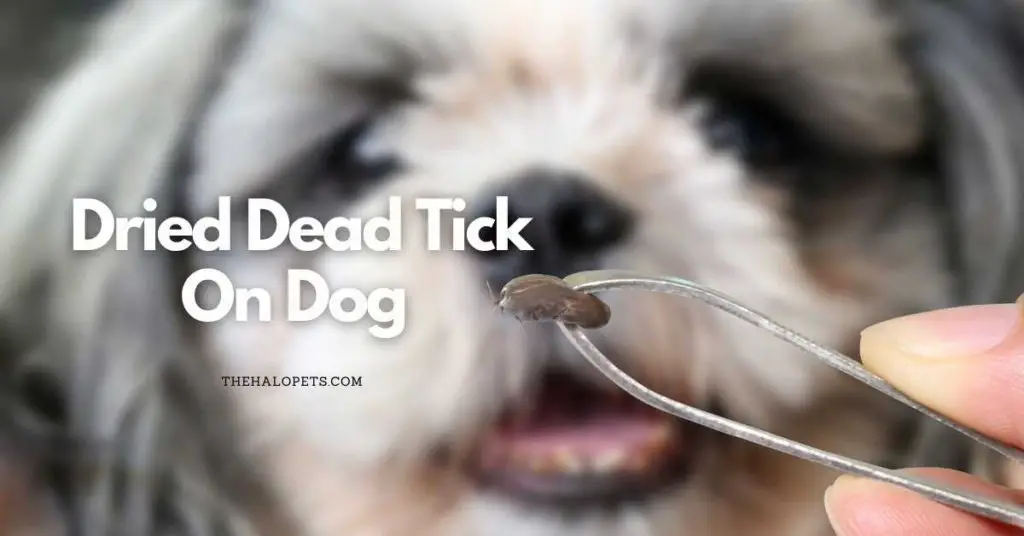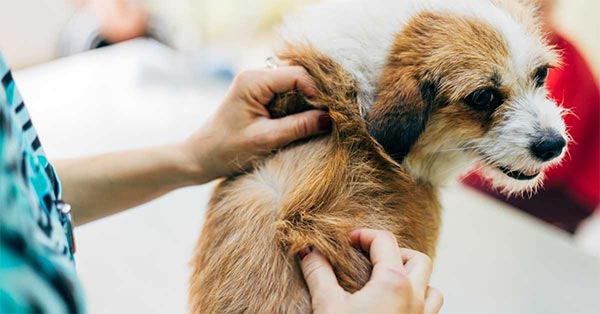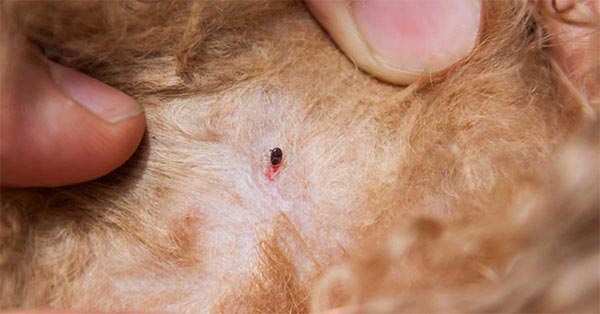Dried Dead ticks are common in dogs. I first encountered them when my dog came to me for belly rubs. I saw a few bumps on his stomach, neck, and legs. Searching further, I discovered the Dried Dead Tick On Dog. If you want to know more, read on!
In this article, we will cover:
- Dried Dead Tick On Dog
- How To Know If The Tick Is Dead? 4 Ways
- What Does A Dried Up Tick Look Like? 3 Ways
- And more…

Dried Dead Tick On Dog
Dried dead ticks on your dog’s skin can be found by looking at their leg movement, leg position, color, and skin texture. Once confirmed, you can remove them easily by pulling the tick with a tweezer to prevent redness and itchiness on your dog’s skin.
Ticks are a pretty widespread species. According to the American Kennel Club, there are more than 200 species of tick found in the United States. These ticks are found in the parks, grass, lawn, forest, and woods. But nowadays, you can see them in urban and residential areas too.
Ticks are not very fussy eaters, so they can survive on your dog’s skin easily. Ticks connect to your dog by piercing his skin with their mouthparts. Many ticks secrete a sticky, glue-like material that aids in their attachment.
Ticks feed on your dog’s blood once they’ve attached to him and can itch and swell the areas where they attach. Thereby, they can cause great discomfort to your dogs.
If ticks stay on your dog’s skin for up to 24 hours, they may transport the harmful bacteria from their stomach into your dog’s blood. So, dogs can become seriously ill if ticks stay on their body for about 24 hours as ticks transmit diseases to your dog’s bloodstream.
How To Know If The Tick Is Dead? 4 Simple Ways
Before proceeding further, it is necessary to know if what you are looking at is actually a tick or not. Once you know it is a tick, check whether it is alive or dead. Here is how you can know if the tick on your dog’s skin is dead:
1. Check Leg Movement
Since ticks are very small, use a magnifying glass and notice if their legs are moving. If the legs are moving even slightly, it means the tick is not dead. So, it will be feeding on your dog’s blood. Otherwise, the tick is dead.
2. Look At The Leg Position
At the same time, you can check the position of the tick’s legs to know about its status currently. A dead tick has curled, unbending, and rigid legs. Additionally, a dead tick’s legs are generally spread out to the sides.
3. Check The Color
Ticks change color when they have sucked the blood out of your dog. Originally, the ticks are black or brown in color. But as soon as they pierce through your dog’s body and suck blood, they turn white or silver in color. This is a good indication for whether a tick is alive or dead.
4. Feel The Skin
To distinguish a tick from a mole or any other marks on your dog’s body, it is best to touch it. You will feel a hard and smooth body. Moreover, ticks would generally move a little bit when you touch them if they are alive.
What Does A Dried Up Tick Look Like?
Spotting dried ticks can be challenging. At times, pet parents confuse ticks with skin tags and moles on their dog’s body. Thus, it is beneficial to know what a dog tick looks like before removing it.
Ticks have a round and stiff body of about one millimeter. They are generally brown, black, or silverish in color. According to Ryan Llera, DVM, and Ernest Ward, DVM at the VCA Hospital, ticks are not insects, but arachnids as they have eight legs and no antennae. However, you might spot six legs in larvae ticks.
Additionally, ticks can only crawl slowly on your dog’s body. You will never find a tick that can jump, fly, or hop. So, look for all these signs using a magnifying glass when you are looking for ticks on your dog’s body. To be sure, refer to photos available online.
Is It Necessary To Remove Dead Ticks On Dogs?

Although dead ticks are slightly less dangerous than alive ones, you cannot leave them on your dog’s body forever. They need to be removed too.
Dead ticks are unable to transmit diseases like Lyme Disease, yet they can cause redness, irritation, bumps, and skin inflammation if not removed properly.
Can Ticks Die While Attached To A Dog?
While attached to a dog’s body, a tick can die. There could be three reasons for the dried dead tick on your dog.
To begin with, as preventive measures, pet parents usually apply anti-tick topical creams and powders that are effective in killing the tick when it bites into the skin.
Additionally, oral preventative medications are also administered to dogs. When the dog is bitten by a tick, the treatment kills the tick in a matter of a few minutes.
And finally, sometimes ticks irritate the dogs. As a result, they scratch the affected area with their paws or bite it with their teeth. This can kill the tick.
When all of this is happening, if the tick has already started sucking the blood out of your dog, it will remain in that position even after being killed because of its mouth-lock mechanism. The mouth of the tick remains locked till it completes feeding.
Once done, the tick releases its mouth but stays attached to your dog. Over time, the tick dehydrates, curls up, and dries there only. It is why you see dried dead ticks on your dog’s fur often.
Can A Dead Tick Fall Off From My Dog’s Skin?
This is a common misconception that it is always a dead tick that falls off a dog’s skin. When a tick latches onto the skin of your dog, it begins sucking blood and enlarges. This process will last a few days. The tick’s color changes from black to silver, and its size increases by tenfolds.
When the tick has had enough blood in its stomach, it is about the size of a small grape. Sizes range from one millimeter to ten millimeters in this case. After that, the ticks’ mouth locking mechanism relaxes as mentioned earlier, the ticks become loose, and they fall.
It is not always possible that this is a dead tick that has fallen off. It might be a live tick seeking refuge to consume the blood it has fed. It will then search for the next host, and the cycle will repeat itself in the same manner.
How To Remove Dead Ticks On My Dog?

If you have ever removed live ticks from your dog’s body, you will be happy to know removing dead ticks requires the same procedure. However, if you are encountering ticks for the first time in your life, do not worry. Here is a step-by-step guide on how to remove dead ticks on your dog:
1. Locate The Dead Ticks
The first step involves carefully examining the body of your dog. Use a magnifying glass and see the areas where dead ticks are. If your dog has long and thick fur, it might take some time for you!
Generally, dead ticks can be found behind the ears, under the legs, stomach, mouth, and neck of your dog. You can identify dead ticks from the signs we have mentioned.
2. Remove The Ticks
To remove the tick completely, you will have to remove the mouth and head of the tick as well. To remove the head from your dog’s skin, wear gloves and use a sharp tweezer to pull it out. We recommend you to use the TickCheck Tick Removal Kit available on Amazon.
Do not use soap and other chemicals on your dog’s skin as it can irritate them. Some pet parents use fire to kill ticks and remove them. We strictly discourage it as fire can burn your dog’s fur and skin.
Remember do not constantly keep trying if you are unable to remove the tick head. It may cause skin inflammation and redness. You can leave it as it is. Eventually, your dog’s body will eject it out on its own. Also, the bite would naturally heal as well.
3. Clean The Infected Area
Once you have removed the head and mouth, it is time to disinfect the affected area. For this, you can use rubbing alcohol or hydrogen peroxide as an antiseptic liquid.
Take a generous amount on a cotton pad and apply it on the wound and surrounding areas of your dog’s skin. If you see redness or inflammation, apply over-the-counter ointments to the affected areas.
Once you are done, do not forget to discard the gloves and clean the tweezers thoroughly with rubbing alcohol. You do not want any infection in your house!
If you are facing serious troubles in removing the ticks, take your dog to the veterinarian. They are experienced professionals who can do this job better than us. Afterwards, they can even perform a complete medical check-up to see if the ticks have caused any diseases.
How To Prevent Dried Dead Ticks On My Dog? 3 Ways

To prevent dead tick situations from arising, you can follow some safety precautions for your dogs. Jennifer Kvamme, DVM at PetMD lists down a few steps you can take. We will discuss some of them one by one:
1. Check Your Dog Regularly
After taking your dog out to a park, make sure you check your dog’s fur patiently for ticks.
Check in and around the ears, tail, under dog collar, between toes, neck, mouth, and around the eyelids.
If you spot any tick, remove them carefully. The early removal of ticks can prevent serious illness in your dog.
2. Reduce The Tick Habitat
As you know by now, ticks are found in grasses, lawns, and parks. So, if you have a lawn in your house, make sure you regularly trim the bushes and grass there. The lesser the area for ticks to breed, the fewer ticks you need to be concerned with.
If the problem is severe in your lawn, contact a garden service or pet store to get your lawn sprayed or treated.
These stores provide yard sprays and granular treatments and handle all the chemicals properly. Thus, you do not have to be worried about your dog’s health.
3. Use Tick Preventive Medications
These days, the market is flooded with tick-resistant products- tick collars, topical ointments, and oral medications.
Talk to your veterinarian about it and choose the best product according to your dog’s needs.
Is It Normal For Dogs To Have A Scab Or Small Bump After Tick Removal?

After successfully removing ticks from your dog’s fur, it is usual for you to see a small and red bump on your dog’s body. Usually, these bumps disappear on their own after a few days, but this is not the case every time.
But if you see your dog scratching the tick bit continuously, do check it. Tick bites aren’t itchy, so it can be a sign that a tick infection has developed. This generally occurs when ticks stay attached to your dog for more than 36 hours. The symptoms of infection near tick bite are redness, scratching, and pus oozing out of the wound.
In some occurrences, a dog can be affected by Lyme Disease as well. According to Ryan Llera, BSc, DVM; Ernest Ward, DVM, at the VCA Hospital, Lyme disease is generally caused by deer ticks. This happens when live deer ticks release the bad bacteria from their stomach into your dog’s bloodstream.
To differentiate between Lyme disease from normal red scabs or bumps, you should look out for the following symptoms:
- A red rash with a clear or white center that keeps on expanding every day
- High Fever
- Limping
- Extreme body aches
- Stiffness in neck
- General symptoms like vomiting, fatigue, loss of appetite, and weight loss.

